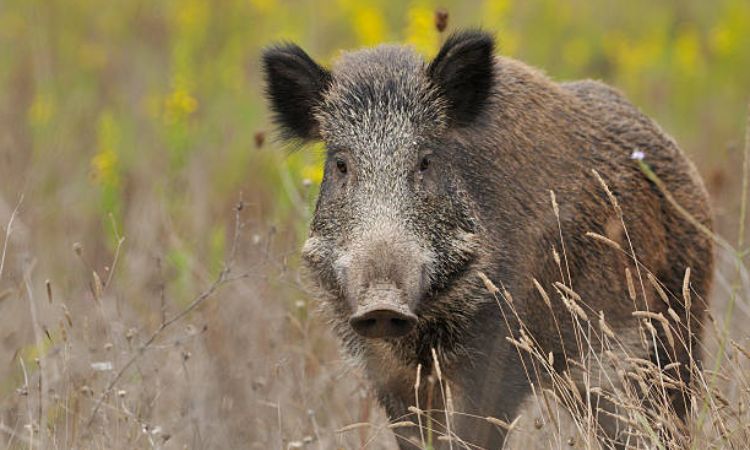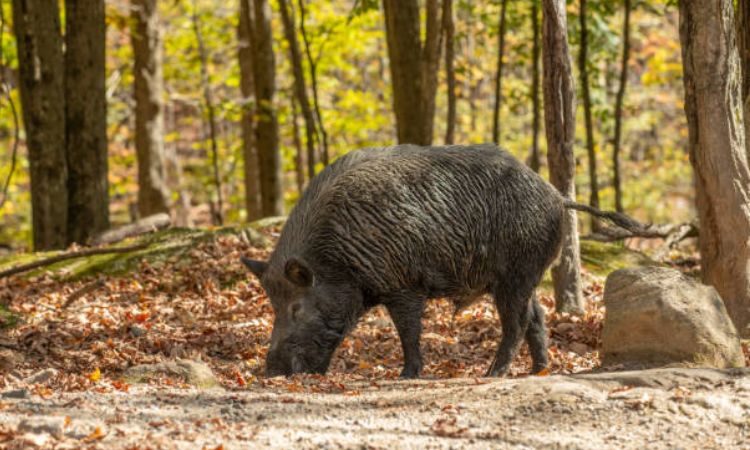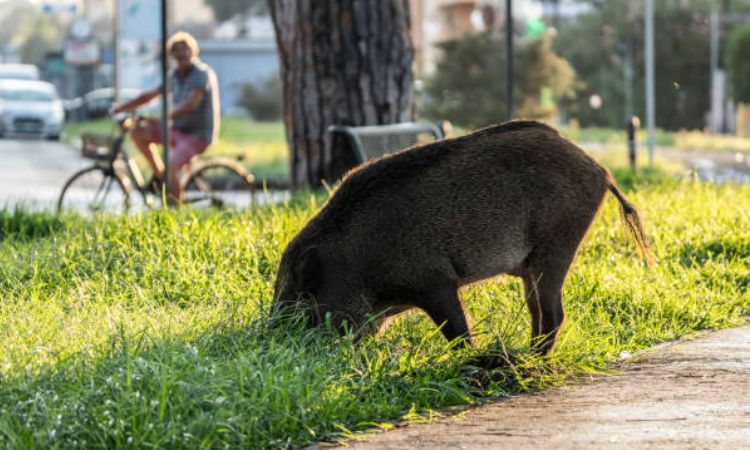From the shadowy depths of European forests to the sun-drenched wetlands of Florida, the wild boar is a creature of power, adaptability, and controversy. This sturdy suid, known scientifically as Sus scrofa, roams much of Eurasia and North Africa, and has established populations across the Americas and Oceania.
With a diet as varied as its habitat from roots and nuts to small animals and carrion this omnivorous forager has earned a reputation for both ecological impact and relentless survival. In Florida, the feral pig problem has brought the wild boar into the spotlight, highlighting the challenges of managing an invasive yet fascinating species.
Wild Boar Overview: A Global and Invasive Species

Scientific Classification and Nomenclature
Wild boars belong to the species Sus scrofa, a member of the family Suidae. This species is widely recognized under various common names, including feral hog, wild hog, feral swine, razorback, and wild pig, depending on the region and context. While native to much of Europe, Asia, and North Africa, in North America they are considered a non-native invasive species, posing ecological and agricultural challenges.
Origin and History
- Native Range: Wild boars are indigenous to forests and woodlands across Europe, northern Africa, and large parts of Asia, including India and China. They are highly adaptable mammals, capable of thriving in diverse habitats, from dense forests to open agricultural land.
- Introduction to the Americas: Wild boars were first introduced to the Americas by European explorers. Historical records suggest that Spanish explorer Hernando de Soto may have brought pigs to Florida as early as 1539. Subsequent introductions included deliberate releases and escapes from domestic farms, contributing to the establishment of feral populations.
- Modern North American Population: Today, wild boars in North America are descendants of multiple sources: escaped domestic pigs, introduced Eurasian wild boar, and hybrid crosses. Their populations have spread to most U.S. states, with particularly high numbers in Florida, Texas, and other southern regions. These animals are highly adaptable, reproduce rapidly, and are considered a major invasive species due to their destructive feeding habits and ecological impact.
Key Wild Boar Characteristics (Facts and Stats)
Physical Description and Mass
- Average Weight/Mass: Wild boars generally weigh between 150 and 220 lbs, though exceptionally large males can exceed 300 lbs in rare cases.
- Size: Their body length ranges from 3 to 6 feet, with shoulder height typically around 2.5–3 feet.
- Distinctive Features: Wild boars have thick, coarse fur that ranges from dark brown to black, providing protection and camouflage. Both males and females have tusks (elongated canine teeth) used for defense and dominance fights. They possess cloven hooves and a long, flexible snout specially adapted for rooting in the soil. Mature males develop a thick shoulder “shield” to protect themselves during combat. Piglets are born with striped, caramel-colored coats for camouflage, which darken as they mature.
Diet and Feeding Behavior
- Diet Classification: Omnivorous; wild boars consume both plant and animal matter.
- Primary Food Sources: Their diet includes roots, tubers, bulbs, seeds, nuts (like acorns), fruits, grasses, invertebrates (earthworms, insects), small vertebrates (eggs, birds, rodents), and carrion. They are opportunistic feeders and adapt their diet to the availability of food in their environment.
- Key Behavior – Rooting: Wild boars use their strong snouts and neck muscles to dig into soil and leaf litter, a behavior called rooting. This allows them to access underground food but often damages crops, gardens, and natural habitats, making them one of the most destructive invasive species where they are introduced.
Reproduction and Social Structure
- Reproductive Rate: Wild boars reproduce rapidly. The gestation period is approximately 115 days, and sows can produce two litters per year under favorable conditions.
- Litter Size: Typically, a litter contains 4–12 piglets, though environmental conditions can influence litter size.
- Social Groups: Females and their young form family groups called sounders, which may merge into larger clusters. Adult males are generally solitary, only joining a sounder temporarily during the mating season to compete for access to females.

Florida’s Feral Pig Problem: Ecological and Economic Impact
Ecological Impact
Feral pigs are omnivorous and opportunistic feeders, using their powerful snouts to root through soil in search of roots, tubers, acorns, and other food. This rooting behavior damages native vegetation, disrupts wetlands, and causes soil erosion. Pigs also prey on small wildlife, including amphibians, reptiles, and ground-nesting bird eggs, putting additional pressure on native species. By competing for food and habitat, feral pigs threaten Florida’s biodiversity and can even contribute to the decline of sensitive or endangered wildlife populations.
In addition, feral pigs often contaminate water sources by wallowing and defecating in ponds, streams, and wetlands. This activity degrades water quality, spreads parasites, and increases the risk of disease transmission to other wildlife and livestock. Some feral pigs carry diseases such as swine brucellosis and pseudorabies, which can affect domestic pigs, cattle, and other animals.
Economic Impact
The economic toll of feral pigs in Florida is substantial. Their destructive feeding and wallowing behavior can devastate crops, orchards, and pasturelands, causing millions of dollars in annual losses for farmers and landowners. Damage to irrigation systems, fences, and roads adds to the financial burden. Nationwide, feral pig damage is estimated at $2.5 billion annually, with Florida accounting for a significant portion due to its large populations and extensive agricultural areas.
Management and Control
Controlling feral pig populations is challenging due to their high reproductive rate—females can produce up to two litters per year, with 4–12 piglets per litter. Management strategies in Florida include regulated hunting, trapping, and population monitoring. Landowners are encouraged to implement exclusion fencing and coordinate with licensed trappers to minimize property damage. Public education campaigns also emphasize reporting sightings and preventing the spread of pigs to new areas.
Despite these efforts, eradication remains unlikely. Instead, management focuses on reducing populations, limiting environmental damage, and protecting agricultural resources. Effective control requires a combination of hunting, trapping, land management, and public cooperation to mitigate the far-reaching impacts of this highly adaptable invasive species.

Management and Control of Feral Swine
Management efforts focus on two main strategies: lethal removal and exclusion. No single method alone can permanently eliminate feral swine, but combining approaches over time can reduce populations and damage.
1. Lethal Removal
Lethal methods aim to reduce feral swine numbers directly and include:
- Trapping: Live traps are commonly used to capture swine, followed by humane euthanasia. Success depends on careful placement, timing, and baiting to lure naïve animals.
- Shooting: Shooting, whether from the ground or aerial platforms, can remove individuals quickly. Aerial shooting is effective for large, inaccessible areas but may require permits.
- Hunting with dogs: This can target small groups or nuisance hogs but is generally insufficient for controlling large populations.
- Snaring: Wire snares may be used in specific situations, requiring experience and adherence to local regulations.
Success in lethal removal depends on several factors:
- Feral swine unfamiliar with humans are easier to trap or shoot.
- Availability of natural food can make it difficult to attract hogs to traps.
- Complete removal in a given area is critical, as even a single sow can re-establish a population in under a year.
2. Exclusion and Fencing
Physical barriers can protect high-value areas such as crops, gardens, or sensitive habitats. Fencing is most effective when combined with population reduction methods, as feral swine can be persistent and adaptive.
Challenges and Considerations
- Adaptability: Feral swine quickly learn to avoid threats, making repeated efforts and patient strategy essential.
- Nonlethal methods: Strategies such as scare devices, guard animals, or habitat modification are generally ineffective at preventing hog damage.
- Legal restrictions: Laws may limit baiting, shooting, or certain trapping methods. It is essential to follow federal, state, and local regulations.
- Toxicants: Currently, toxicants for feral swine are mostly prohibited, though one EPA-approved warfarin-based bait exists under controlled conditions. Poisoning non-target species remains a significant concern.
Recommended Approach
A successful feral swine management program typically involves:
- Assessment: Evaluate the size and behavior of the local population.
- Planning: Select appropriate control methods, accounting for regulations, terrain, and seasonal factors.
- Combination Methods: Integrate lethal removal with exclusion measures to maximize effectiveness.
- Persistence: Monitor populations and repeat efforts as needed to maintain control.
Wild boars are powerful, adaptable animals with a wide-ranging diet and complex social behavior. In places like Florida, feral populations cause significant habitat and crop damage and pose disease risks. Effective management relies on understanding their biology and behavior to protect both ecosystems and agriculture.
